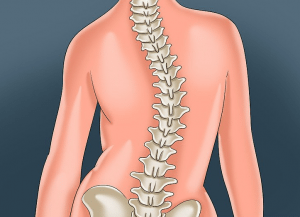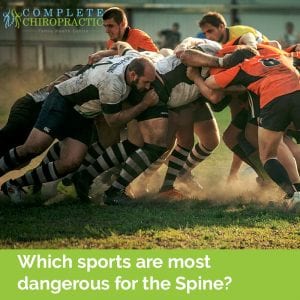Sport is great – whether you’re a team player or a lone wolf, a gym fanatic or a weekend warrior, there’s bound to be some form of physical activity which is fun for everyone. We 100% encourage our patient’s to participate vigorously and regularly in the sport of their choice – but also to keep the potential risks in mind.
Sport and the spine
Sports, going to the gym or just getting physically active are good for the body and god for the spine. Strengthening exercises can help to improve the health and efficiency of the muscles which support your spine, whereas cardiovascular exercise can help to burn fat (which puts extra pressure on the spine) and improve overall health factors, like blood flow. Some sports, however, also pose a substantial risk of spinal or more generally, back, injury.
There’s no need to avoid activities which carry an increased risk – instead, simply be aware of the potential impact your chosen sport may have so that if you notice symptoms of discomfort you can make the association and head in for a quick chiropractic check-up before anything more painful develops! Let’s look at some common risky activities for the spine.
Cheerleading
Believe it or not, research conducted in the US[1] has suggested that that cheerleading is quite possibly the most dangerous sport played among high school and college-age students. While the sport is certainly more popular across the pond, it’s rapidly gaining in popularity in the UK. The findings in relation to cheerleading are also relevant since many of the same risks are present in, for example, gymnastics. The main risks come from trips, falls and individuals being dropped as part of Arial routines – but another risk factor is that many cheerleaders try to progress to new techniques and routines before they’re ready, resulting in injuries. Injuries also occur due to improper training on cheerleading technique and not having enough spotters for complicated stunts can also lead to serious injuries. Bad landings, in particular, place a great deal of stress on the spine, and can easily lead to the condition known as subluxation.
From 1982 to 2009, cheerleading accounted for 65 percent of all serious injuries to high school female athletes and 70 percent to college female athletes in the US – a figure we should keep in mind!
Gymnastics
Having just mentioned gymnastics, let’s expand a bit – Gymnastics and cheerleading have many similarities, but since gymnastics isn’t a contact sport, you might be surprised to see it on the list.
There are certainly fewer injuries which occur as a result of gymnastics (although injuries due to accidents associated with mounting and dismounting equipment are common) – but research suggests that gymnasts, as well as ballet dancers, are at particular risk of developing long term spinal conditions – especially Scoliosis. It is not yet clear whether participating in gymnastics actually causes scoliosis, but there is a certain reason to suspect that the contortion and stretching involved may either spark off or at least exacerbate the condition.
Horse riding
Horse riding, while often seen as the preserve of the wealthy, is now more accessible than ever and is also being recognised for the psychological benefits which bonding with and taking care of a horse can have for many people. Indeed, especially good-natured horses are now often used for activities with the disabled, bringing joy to many.
Judging the risk associated with horse riding is difficult – a slow trot on a well-trained and good-natured horse is fairly low risk, but some versions of the sport, including racing or jumping, impose a great deal of stress on the horse and the rider. It’s easy to suffer a back injury during such activities, or during a fall, which could happen at any time. It’s estimated that 74,499 people were treated in emergency rooms for horseback-related injuries in 2009 – and estimates suggest that horseback riders should expect an injury for every 350 hours spent riding, that compared poorly with even motorcyclists, who should expect an injury for every 7,000 hours spent riding![2]
Most serious horseback riding injuries occur when a person falls or is bucked off their horse. Most often, the injury happens when the rider tries to break his or her fall, which results in bruises, sprains, and fractures to the wrists or arms. In some serious cases, damage to the spine and back may occur. If such an injury does occur you should always seek a chiropractic evaluation, even if you do not feel any immediate pain or discomfort.
Rugby
You probably expected to see rugby on this list – although it is further down than you might have suspected! Rugby (especially full contact rugby) is, of course, dangerous for the spine, and indeed, for the whole body. The risk associated with any full-contact sport means that rugby will always appear on these kind of lists, but at the same time, it’s important to acknowledge the effort which the sport as a whole has put into reducing risks and managing issues such as concussion over recent years. A real focus on injury prevention has now made the sport safer than ever before – but obviously the risks of sprains, strains and fractures to the spine or supporting structures remain very real.
Even with much stricter action on foul play, and a great emphasis on safe form, It’s not possible to rule out (or even much reduce) the risk of an accident occurring on the field – its easy to trip, fall or simply lose your balance in a way which ends up causing damage. Where you can make a difference is off the field, before the game even starts. Even a slight injury of the sort which a rugby player would typically not think much of, may affect balance, gait or the ability of the body to absorb a shock – therefore, if you’re into rugby, seek regular chiropractic check-ups, and get any aches, strains or joint impingements treated in advance, so you can at least start the game without an increased risk of an accident.
Football
Since football is, in theory at least, a non-contact sport, and one which is generally associated with less severe injuries it’s less of a concern than may sports. It makes it on to this list since it’s so widely played, however.
In football, ankle injuries are more of a worry than anything which directly impacts the spine, Most are primarily caused by either jumping in proximity to other players or as a result of the strain placed on the ankle during quick changes of direction.[3] The same type of action is also often responsible for a painful and slow to heal injury to the anterior cruciate ligament (ACL). Taking good care of your body, and (as with rugby) getting any issues with posture or gait taken care of at a professional clinic – either with chiropractic, or sports therapy treatment – can go a long way to preventing these injuries occurring. Sports therapy, in particular, can assist a great deal when an ACL injury has already taken place.
There are still a couple of ways in which the spine can be impacted by football, however. Firstly, “Heading” may have some risk for younger children – while serious injury is unlikely, heading can be dangerous for the neck (the cervical spine). While the odd header probably won’t do you any harm, research suggests that multiple impacts may, over time produce bony changes in the cervical spine and predispose a player to related degenerative disease later in life[4]. Secondly, as with rugby, injuries or imbalances which are left untreated can predispose you to a trip or fall, which may injure the spine. This factor is perhaps more pronounced during critical moments of the game which occur at high speed when a player could fall an impact the ground with some considerable force.
[1] See American Academy of Paediatrics (2012) Cheerleading Injuries: Epidemiology and Recommendations for Prevention, Policy Statement
[2] http://news.bbc.co.uk/1/hi/magazine/8339097.stm
[3] J Athl Train 2007:42:38l-7
[4] Pain Physician 2005:8391-7


